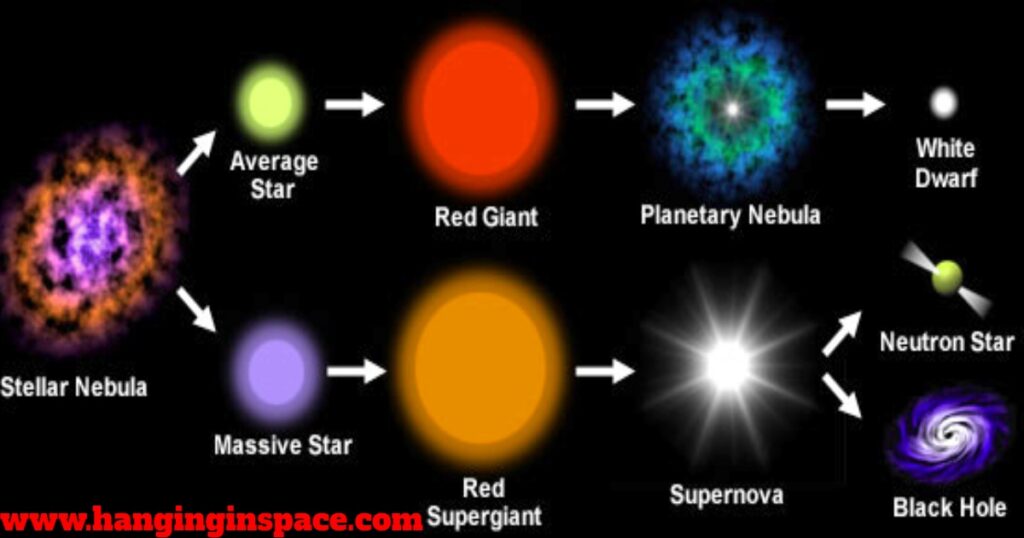The life cycle of a star from its birth to its death is a little complex. A star may end up becoming a white dwarf or a neutron star or a black hole depending on the process it goes through.

We will briefly discuss the life cycle of a star in different phases.
Case 1: Life Cycle of a (Small or Average) Star from Stellar Nebula to White Dwarf
1. Stellar Nebula Formation:
The life cycle of a star starts inside a stellar nebula, which is a huge cloud of gas and dust in space. Particles in the nebula condense and create regions of greater density due to gravitational forces, which ultimately result in the development of a protostar.
2. Protostar to Average Star:
The gravitational pressure at the protostar’s core rises as it gains mass. An average star is born when nuclear fusion sparks when enough pressure is reached. In this phase, enormous amounts of energy are released as hydrogen atoms fuse to form helium.
3. The Red Giant Stage:
A star runs out of hydrogen fuel after stable fusion for billions of years. The outer layers expand and cool while the center compresses and heats up due to running out of fuel. The star changes from being a red giant to a red giant, getting bigger and colder.
4. Formation of a Planetary Nebula:
A brilliant rim of ionized gas encircling the core is called a planetary nebula, and it forms as the red giant sheds its outer layers. Expelled material adds elements necessary for the development of new stars and planetary systems to the surrounding interstellar medium.
5. White Dwarf Remnant:
The star’s core is visible once its outer layers have been driven out. It turns into a white dwarf, a tiny, extremely dense star remnant. The white dwarf cools over billions of years, emitting residual heat even though it is no longer performing fusion, and eventually goes dark. The life cycle of a star ends by becoming a white dwarf, in this case.

Case 2: Life Cycle of a (Massive) Star from Stellar Nebula to Neutron Star or Black Hole
1. Stellar Nebula Formation:
The life cycle of a star starts inside a stellar nebula, which is a huge cloud of gas and dust in space. Greater density areas inside the nebula collapse due to gravity, creating a protostar, which is a dense core encircled by a revolving disk of gas and dust.
2. Protostar to Massive Star:
Gravitational pressure increases at the protostar’s core as it gains mass. A star transforms into a big star when its core achieves temperatures and pressures high enough for nuclear fusion. The star’s light is produced by fusion events, which mostly convert hydrogen into helium and release enormous amounts of energy.
3. Red Supergiant Phase:
Massive stars evolve more quickly than typical stars, moving through several stages of development more quickly. They eventually mature into red supergiants, growing larger and becoming colder. In this stage, heavier elements are produced in the core by fusion processes.
4. Supernova Event:
A huge star’s life cycle ends in a spectacular supernova explosion. A catastrophic explosion is caused when the core collapses under the force of its own gravity after running out of nuclear fuel. Massive amounts of energy are released by supernovae, which can briefly outshine entire galaxies and scatter heavy elements into space.
5. Formation of a Neutron Star:
The core remnants of a large star may continue to collapse after a supernova, eventually producing a neutron star. Because neutrons are typically packed closely together, neutron stars are extraordinarily dense. They have strong gravity fields, and their magnetic poles radiate strong radiation beams. The life cycle of a star ends here by becoming a neutron star, in this case.
OR
5. Formation of a Black Hole:
Following a supernova, the remnants of the massive star’s core may undergo further collapse, forming a black hole. Black holes are regions of spacetime where gravity is so intense that nothing, not even light, can escape their gravitational pull. They are characterized by a point of infinite density known as a singularity, surrounded by an event horizon, the boundary beyond which no information or matter can escape. The life cycle of a star ends here by becoming a black hole, in this case.
Conclusion:
In conclusion, the life cycle of a star is a captivating journey that spans millions to billions of years, characterized by dramatic transformations and breathtaking phenomena. From the birth of stars in dense molecular clouds to their eventual demise as white dwarfs, neutron stars, or even black holes, each stage offers unique insights into the fundamental processes that govern the universe.